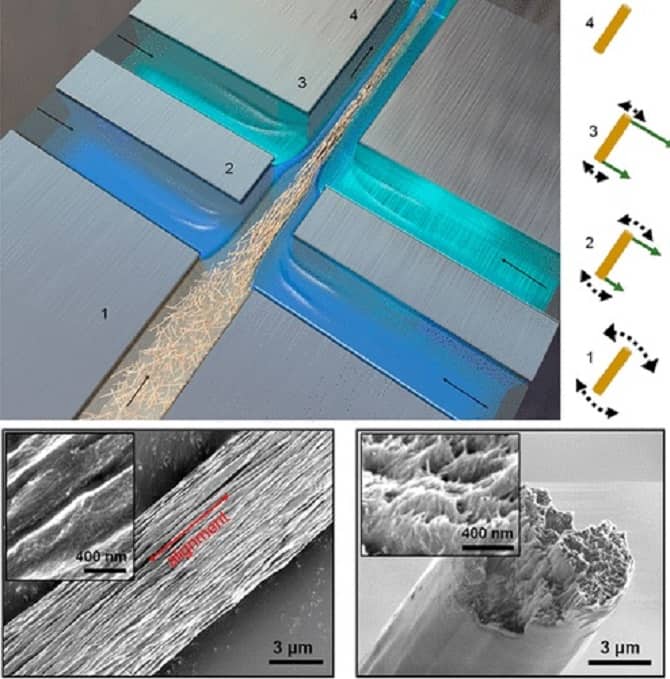
Lightweight strong materials that can resist huge amounts of mechanical stress are in demand for many modern technologies. Surprisingly enough, the inspiration for these cutting-edge resistant materials can come from one of the first materials that mankind used to build utensils – wood. A group of researchers led by Daniel Söderberg at Wallenberg Wood Science Center in Stockholm, Sweden have developed a method for building long fibres starting from cellulose nanofibrils (CNFs). They looked at the architecture of wood and devised a method that can produce a glass-like material that is stronger and stiffer than many other synthetic and natural fibre compounds, such as dragline silk, steel, and E-Glass, to name just a few.
The main challenge when trying to build macroscopic structures using nanoscale blocks is that it is difficult to transfer the mechanical properties of the blocks to the structure. So in general no matter how strong the single elements are, the resulting macroscale structures are often much weaker.
In natural wood the crystalline CNFs are embedded in a matrix made of hemicelluloses and lignins. Cross-links in this matrix and the unique arrangement of glucose chains make CNFs in wood stiff and strong. However, due to lack of suitable assembly mechanisms, hierarchical scale materials produced from these components are 3-15 times weaker. Furthermore, the colloidal behaviour of CNFs in liquids is complicated compared with other nanomaterials due to its kinky morphology. To solve this problem, scientists in Söderberg’s group developed a bioinspired assembly technique, reported in ACS Nano.
Fibre flow
Söderberg and team inserted a suspension of CNFs in a channel. Due to the presence of Brownian diffusion and electrostatic repulsion the CNF alignment at this stage is minimal. This main channel containing the CNFs then meets two perpendicular channels. The first pumps in deionized water, which provokes an initial hydrodynamic alignment of CNFs and prevents a sudden transition to the glass-state through promotion of electrostatic repulsion. The second pumps in low pH acids, which counteracts Brownian diffusion and electrostatic repulsion. The end result is a well packed state with maximal CNF-CNF contact. Although the idea may seem relatively simple, the process requires constant in situ monitoring and a careful study of the relationship between fibril characteristics (length, charge, etc.) and mechanical characteristics.

Wood-based ‘supermaterial’ is stronger and tougher than steel
Mittal and Söderberg, alongside Christophe Brouzet and Fredrik Lundell have also now devised a method for studying the how the rotational dynamics of suspensions of nanoscale fibres depend on fibre length. The approach aims to better understand how the range of lengths often found in these systems affects their behaviour, and may help to characterize the subtle interplay between Brownian diffusion and nanoparticle alignment.
The authors conclude that the results show “the central role of processing strategies and associated fundamental parameters on realizing the true potential of nanoscale building blocks”. Nitesh Mittal, first author of the study, claims that “interestingly, the strongest CNFs are 1.2-1.5 times stronger than wet-spun carbon nanotubes and graphene fibres”. Their bioinspired assembly technique may now provide a way to fully exploit this strength.



